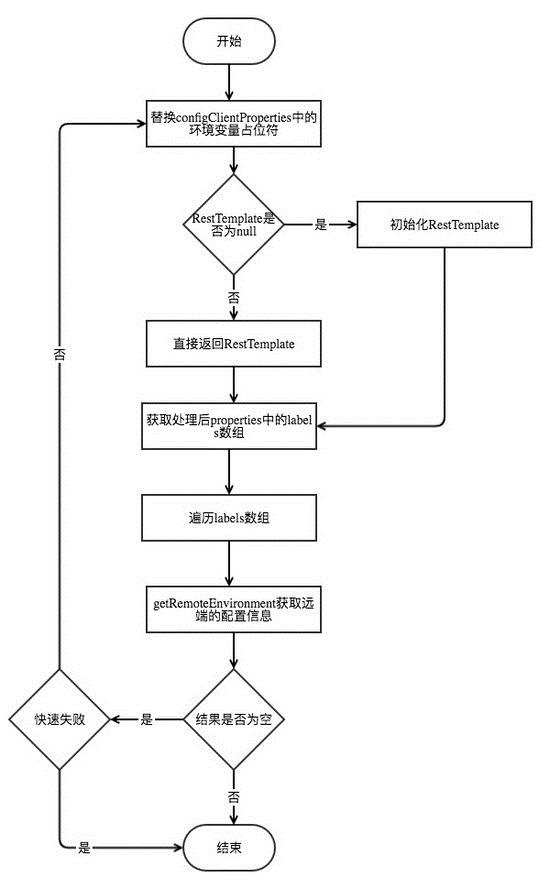应用的配置源通常都是远端的config server服务器,默认情况下,本地的配置优先级低于远端配置仓库。如果想实现本地应用的系统变量和config文件覆盖远端仓库中的属性值,可以通过如下设置:
|
1
2
3
4
5
6
|
spring:
cloud:
config:
allowoverride: true
overridenone: true
overridesystemproperties: false
|
- overridenone:当allowoverride为true时,overridenone设置为true,外部的配置优先级更低,而且不能覆盖任何存在的属性源。默认为false
- allowoverride:标识overridesystemproperties属性是否启用。默认为true,设置为false意为禁止用户的设置
- overridesystemproperties:用来标识外部配置是否能够覆盖系统属性,默认为true
客户端通过如上配置,可以实现本地配置优先级更高,且不能被覆盖。由于我们基于的spring cloud当前版本是 edgware.release ,上面的设置并不能起作用,而是使用了 propertysourcebootstrapproperties 中的默认值。具体情况见issue:https://github.com/spring-cloud/spring-cloud-commons/pull/250,我们在下面分析时会讲到具体的bug源。
源码分析
configservicepropertysourcelocator
覆写远端的配置属性归根结底与客户端的启动时获取配置有关,在获取到配置之后如何处理?我们看一下spring cloud config中的资源获取类 configservicepropertysourcelocator 的类图。
configservicepropertysourcelocator 实质是一个属性资源定位器,其主要方法是 locate(environment environment) 。首先用当前运行应用的环境的application、profile和label替换configclientproperties中的占位符并初始化resttemplate,然后遍历labels数组直到获取到有效的配置信息,最后还会根据是否快速失败进行重试。主要流程如下:
locate(environment environment) 调用 getremoteenvironment(resttemplate, properties, label, state) 方法通过http的方式获取远程服务器上的配置数据。实现也很简单,显示替换请求路径path中占位符,然后进行头部headers组装,组装好了就可以发送请求,最后返回结果。
在上面的实现中,我们看到获取到的配置信息存放在 compositepropertysource ,那是如何使用它的呢?这边补充另一个重要的类是propertysourcebootstrapconfiguration,它实现了applicationcontextinitializer接口,该接口会在应用上下文刷新之前 refresh() 被回调,从而执行初始化操作,应用启动后的调用栈如下:
|
1
2
|
springapplicationbuilder.run() -> springapplication.run() -> springapplication.createandrefreshcontext() -> springapplication.applyinitializers() -> propertysourcebootstrapconfiguration.initialize()
propertysourcebootstrapconfiguration
|
而上述 configservicepropertysourcelocator 的locate方法会在initialize中被调用,从而保证上下文在刷新之前能够拿到必要的配置信息。具体看一下initialize方法:
|
1
2
3
4
5
6
7
8
9
10
11
12
13
14
15
16
17
18
19
20
21
22
23
24
25
26
27
28
29
30
31
32
33
34
35
36
37
38
39
40
41
42
43
44
45
46
|
public class propertysourcebootstrapconfigurationimplements
applicationcontextinitializer<configurableapplicationcontext>, ordered {
private int order = ordered.highest_precedence + 10;
@autowired(required = false)
private list<propertysourcelocator> propertysourcelocators = new arraylist<>();
@override
public void initialize(configurableapplicationcontext applicationcontext){
compositepropertysource composite = new compositepropertysource(
bootstrap_property_source_name);
//对propertysourcelocators数组进行排序,根据默认的annotationawareordercomparator
annotationawareordercomparator.sort(this.propertysourcelocators);
boolean empty = true;
//获取运行的环境上下文
configurableenvironment environment = applicationcontext.getenvironment();
for (propertysourcelocator locator : this.propertysourcelocators) {
//遍历this.propertysourcelocators
propertysource<?> source = null;
source = locator.locate(environment);
if (source == null) {
continue;
}
logger.info("located property source: " + source);
//将source添加到propertysource的链表中
composite.addpropertysource(source);
empty = false;
}
//只有source不为空的情况,才会设置到environment中
if (!empty) {
//返回environment的可变形式,可进行的操作如addfirst、addlast
mutablepropertysources propertysources = environment.getpropertysources();
string logconfig = environment.resolveplaceholders("${logging.config:}");
logfile logfile = logfile.get(environment);
if (propertysources.contains(bootstrap_property_source_name)) {
//移除bootstrapproperties
propertysources.remove(bootstrap_property_source_name);
}
//根据config server覆写的规则,设置propertysources
insertpropertysources(propertysources, composite);
reinitializeloggingsystem(environment, logconfig, logfile);
setloglevels(environment);
//处理多个active profiles的配置信息
handleincludedprofiles(environment);
}
}
//...
}
|
下面我们看一下,在 initialize 方法中进行了哪些操作。
- 根据默认的 annotationawareordercomparator 排序规则对propertysourcelocators数组进行排序
- 获取运行的环境上下文configurableenvironment
- 遍历propertysourcelocators时
- 调用 locate 方法,传入获取的上下文environment
- 将source添加到propertysource的链表中
- 设置source是否为空的标识标量empty
- source不为空的情况,才会设置到environment中
返回environment的可变形式,可进行的操作如addfirst、addlast
移除propertysources中的bootstrapproperties
根据config server覆写的规则,设置propertysources
处理多个active profiles的配置信息
初始化方法 initialize 处理时,先将所有propertysourcelocator类型的对象的 locate 方法遍历,然后将各种方式得到的属性值放到compositepropertysource中,最后调用 insertpropertysources(propertysources, composite) 方法设置到environment中。spring cloud context中提供了覆写远端属性的 propertysourcebootstrapproperties ,利用该配置类进行判断属性源的优先级。
|
1
2
3
4
5
6
7
8
9
10
11
12
13
14
15
16
17
18
19
20
21
22
23
24
25
26
27
28
29
30
31
32
33
34
35
36
|
private void insertpropertysources(mutablepropertysources propertysources,
compositepropertysource composite) {
mutablepropertysources incoming = new mutablepropertysources();
incoming.addfirst(composite);
propertysourcebootstrapproperties remoteproperties = new propertysourcebootstrapproperties();
new relaxeddatabinder(remoteproperties, "spring.cloud.config")
.bind(new propertysourcespropertyvalues(incoming));
//如果不允许本地覆写
if (!remoteproperties.isallowoverride() || (!remoteproperties.isoverridenone()
&& remoteproperties.isoverridesystemproperties())) {
propertysources.addfirst(composite);
return;
}
//overridenone为true,外部配置优先级最低
if (remoteproperties.isoverridenone()) {
propertysources.addlast(composite);
return;
}
if (propertysources
.contains(standardenvironment.system_environment_property_source_name)) {
//根据overridesystemproperties,设置外部配置的优先级
if (!remoteproperties.isoverridesystemproperties()) {
propertysources.addafter(
standardenvironment.system_environment_property_source_name,
composite);
}
else {
propertysources.addbefore(
standardenvironment.system_environment_property_source_name,
composite);
}
}
else {
propertysources.addlast(composite);
}
}
|
上述实现主要是根据 propertysourcebootstrapproperties 中的属性,调整多个配置源的优先级。从其实现可以看到 propertysourcebootstrapproperties 对象的是被直接初始化,使用的是默认的属性值而并未注入我们在配置文件中设置的。
修复后的实现:
|
1
2
3
4
5
6
7
8
9
10
11
12
|
@autowired(required = false)
private propertysourcebootstrapproperties remotepropertiesforoverriding;
@override
public int getorder(){
return this.order;
private void insertpropertysources(mutablepropertysources propertysources,
compositepropertysource composite) {
mutablepropertysources incoming = new mutablepropertysources();
incoming.addfirst(composite);
propertysourcebootstrapproperties remoteproperties = remotepropertiesforoverriding == null
? new propertysourcebootstrapproperties()
: remotepropertiesforoverriding;
|
总结
以上所述是小编给大家介绍的spring cloud 覆写远端的配置属性实例详解,希望对大家有所帮助,如果大家有任何疑问请给我留言,小编会及时回复大家的。在此也非常感谢大家对快网idc网站的支持!
原文链接:http://blueskykong.com/2018/01/23/config-server2
相关文章
- 64M VPS建站:怎样选择合适的域名和SSL证书? 2025-06-10
- 64M VPS建站:怎样优化以提高网站加载速度? 2025-06-10
- 64M VPS建站:是否适合初学者操作和管理? 2025-06-10
- ASP.NET自助建站系统中的用户注册和登录功能定制方法 2025-06-10
- ASP.NET自助建站系统的域名绑定与解析教程 2025-06-10
- 2025-07-10 怎样使用阿里云的安全工具进行服务器漏洞扫描和修复?
- 2025-07-10 怎样使用命令行工具优化Linux云服务器的Ping性能?
- 2025-07-10 怎样使用Xshell连接华为云服务器,实现高效远程管理?
- 2025-07-10 怎样利用云服务器D盘搭建稳定、高效的网站托管环境?
- 2025-07-10 怎样使用阿里云的安全组功能来增强服务器防火墙的安全性?
快网idc优惠网
QQ交流群
-
2025-05-27 85
-
2025-06-04 98
-
2025-05-29 11
-
2025-05-29 74
-
使用递归删除树形结构的所有子节点(java和mysql实现)
2025-05-29 33










